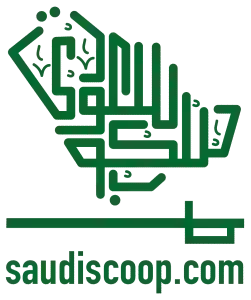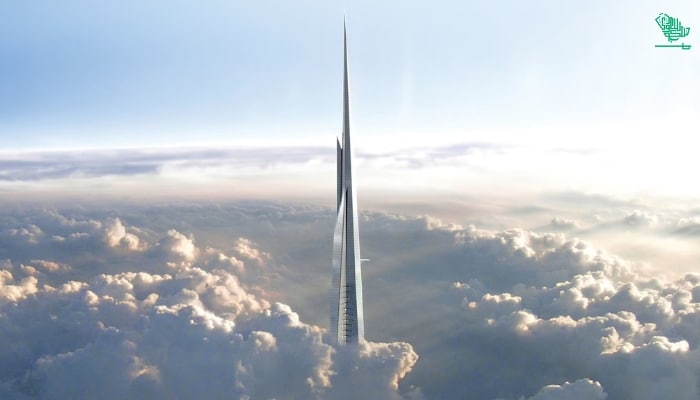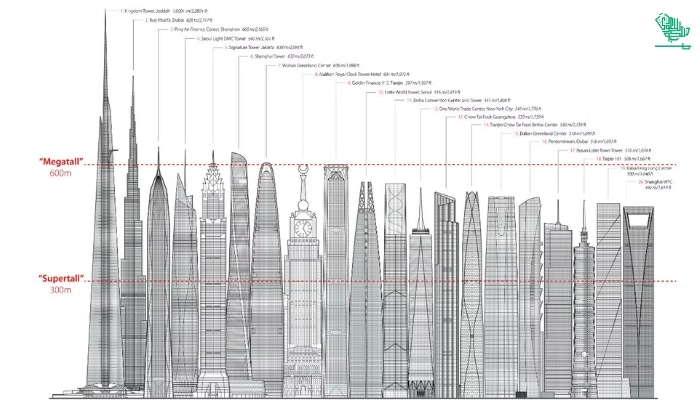Jeddah Tower, once called Kingdom Tower, is a huge skyscraper project in Saudi Arabia. It aims to be the tallest building in the world, standing at a whopping 1 kilometer (3,281 feet) tall. Construction began in 2013 but faced many problems, like labor disputes and corruption scandals, causing delays.
However, construction is back on track, and the tower is expected to be finished soon. It’s part of Jeddah Economic City, a massive development featuring homes, hotels, and offices.
Designed by Adrian Smith + Gordon Gill Architecture, the tower has a sleek, modern look, and it’s meant to resemble a desert plant shooting towards the sky. It’s set to be a big tourist attraction, offering fantastic views of Jeddah and beyond from its observation deck at the top.
Tallest Building in the world
At 828 meters/ 2,717 feet, Burj Khalifa in Dubai is the world’s tallest building. It may eventually be surpassed by a structure in Jeddah, Saudi Arabia, that began construction in 2013 but has stalled in its rise to 1,000 meters at about a quarter of its intended height.
Design and Architecture Of Jeddah Kingdom Tower
The design architect for both towers is Adrian Smith, who, as a partner at the firm SOM, led the team that won the 2003 competition by the developer Emaar Properties. Emaar planned a residential structure that would be the world’s tallest building and serve as the centerpiece of a massive mixed-use development.
Smith’s team also won a 2011 competition for a 1,000-meter structure called initially Kingdom Tower, which was planned for a new development outside the city of Jeddah, the capital of the Kingdom of Saudi Arabia. By 2006, Smith had started an independent firm, Adrian Smith and Gordon Gill Architects, that carried the design forward, with Thornton Tomasetti as the structural engineer.
Both towers employ a structural system called a “buttressed core,” in which three wings flank a tight hexagonal central core of high-performance concrete. The very slender tower is thus very stiff, and both the weight of the structure and lateral loads are carried to the ground as a bearing-wall system.
This is possible because, in residential buildings, floor plans can separate units with solid walls, whereas office buildings require large open floor plates. Within the compact core, the elevator shafts are arranged efficiently to serve the different zones of residences and boutique offices, as the elevation and core diagrams of the Burj Khalifa illustrate.
Economic and Social Impact Of Jeddah Kingdom Tower
The Jeddah Tower is crucial in the ambitious Jeddah Economic City project, spearheaded by Crown Prince Mohammed Bin Salman.
This massive urban development initiative aims to diversify the Saudi economy and create fresh economic prospects by investing in key sectors like tourism, real estate, and infrastructure. Anticipated to become a focal point for tourists and guests, the Jeddah Tower will significantly bolster the region’s tourism sector.
Cultural and Economic Symbolism Of Jeddah Kingdom Tower
The Jeddah Tower embodies more than just urban development and economic progress; it also holds profound cultural and economic significance. Constructed by Emaar, a renowned Dubai-based real estate firm, the tower stands as a symbol of the burgeoning economic collaboration between Saudi Arabia and the United Arab Emirates. Furthermore, its design draws inspiration from traditional Islamic architecture, serving as a homage to the region’s rich cultural heritage.
Conclusion
The Jeddah Tower isn’t just about growth and progress—it’s a big deal for the Middle East. It symbolizes development and economic success and carries cultural and economic weight. Expected to boost tourism and attract visitors and investors worldwide, it’s part of a larger trend of urban development in the region and is set to become a significant landmark.
DISCLAIMER: The images/videos showcased on this page are the property of their respective owners. We provide credit and sources wherever possible. However, If you find that your image/video is displayed on this blog without authorization, please contact us with the relevant details and a link to the image, and we will promptly address your concerns.

Rosa Gardens is a writer at Saudi Scoop, dedicated to delivering insightful and engaging content. With a keen eye for detail and a passion for storytelling, Rosa covers various topics that inform and inspire readers.





